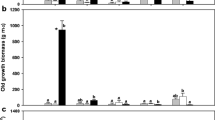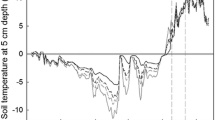Abstract
Deciduous shrub density and landcover are increasing across many areas of the Arctic. Shrub growth may be promoted by a snow–shrub feedback whereby relatively tall shrubs accumulate deeper snow, raising winter soil temperature minima, increasing microbial activity, and enhancing soil solution nitrogen (N). Although there is good evidence for the above components of the hypothesis, it has not yet been determined if shrubs can access the elevated N pool generated by deepened snow. We added isotopic N tracer (15N) in late summer to control and snowfenced low birch hummock tundra to test the influence of deepened snow on N cycling. Furthermore, tracer was added to tall birch tundra to compare N cycling in low and tall shrub ecosystems that have the same species composition. Experimentally deepened snow in low birch tundra did not significantly affect 15N uptake by shrubs or any other species 2 years after the tracer addition. However, there were strong differences between the low and tall birch ecosystems, with the deciduous shrubs and graminoids accumulating more 15N than the evergreen shrubs in the relatively productive tall shrub site, and vice versa in the relatively infertile low birch site. The greater 15N acquisition by birch in the more fertile site, together with the absence of a deepened snow effect on 15N acquisition by any species in the low birch hummock ecosystem, suggest that climate-change induced increases in birch shrub growth and expansion across the landscape will tend to occur most rapidly in and around existing tall birch shrub patches.




Similar content being viewed by others
References
Beck PSA, Goetz SJ (2011) Satellite observations of high northern latitude vegetation productivity changes between 1982 and 2008: ecological variability and regional differences. Environ Res Lett 6:045501
Bilbrough CJ, Welker JM, Bowman WD (2000) Early spring nitrogen uptake by snow-covered plants: a comparison of arctic and alpine plant function under the snowpack. Arct Antarct Alp Res 32:404–411
Bret-Harte MS, Shaver GR, Zoerner JP, Johnstone JF, Wagner JL, Chavez AS, Gunkelman RF, Lippert SC, Laundre JA (2001) Developmental plasticity allows Betula nana to dominate tundra subjected to an altered environment. Ecology 82:18–32
Brookes PC, Landman A, Pruden G, Jenkinson DS (1985) Chloroform fumigation and the release of soil-nitrogen—a rapid direct extraction method to measure microbial biomass nitrogen in soil. Soil Biol Biochem 17:837–842
Buckeridge KM, Grogan P (2008) Deepened snow alters soil microbial nutrient limitations in arctic birch hummock tundra. Appl Soil Ecol 39:210–222
Buckeridge KM, Grogan P (2010) Deepened snow increases late thaw biogeochemical pulses in mesic low arctic tundra. Biogeochemistry 101:105–121
Buckeridge KM, Cen Y-P, Layzell D, Grogan P (2010a) Soil biogeochemistry during the early spring in low arctic mesic tundra and the impacts of deepened snow and enhanced nitrogen availability. Biogeochemistry 99:127–141
Buckeridge KM, Zufelt E, Chu H, Grogan P (2010b) Soil nitrogen cycling rates in low arctic shrub tundra are enhanced by litter feedbacks. Plant Soil 330:407–421
Chapin FS III, Shaver GR, Giblin AE, Nadelhoffer KJ, Laundre JA (1995) Responses of arctic tundra to experimental and observed changes in climate. Ecology 76:694–711
Chapin FS III, Sturm M, Serreze MC, McFadden JP, Key JR, Lloyd AH, McGuire AD, Rupp TS, Lynch AH, Schimel JP, Beringer J, Chapman WL, Epstein HE, Euskirchen ES, Hinzman LD, Jia G, Ping CL, Tape KD, Thompson CDC, Walker DA, Welker JM (2005) Role of land-surface changes in arctic summer warming. Science 310:657–660
Chu H, Grogan P (2010) Soil microbial biomass, nutrient availability and nitrogen mineralization potential among vegetation-types in a low arctic tundra landscape. Plant Soil 329:411–420
Churchland C, Mayo-Bruinsma L, Ronson A, Grogan P (2010) Soil microbial and plant community responses to single large carbon and nitrogen additions in low arctic tundra. Plant Soil 334:409–421
Clemmensen KE, Sorensen PL, Michelsen A, Jonasson S, Stroem L (2008) Site-dependent N uptake from N-form mixtures by arctic plants, soil microbes and ectomycorrhizal fungi. Oecologia 155:771–783
DeMarco J, Mack MC, Bret-Harte MS (2011) The effects of snow, soil microenvironment, and soil organic matter quality on N availability in three alaskan arctic plant communities. Ecosystems 14:804–817
Dijkstra P, Ishizu A, Doucett R, Hart SC, Schwartz E, Menyailo OV, Hungate BA (2006) 13C and 15N natural abundance of the soil microbial biomass. Soil Biol Biochem 38:3257–3266
Elmendorf SC, Henry GHR, Hollister RD, Bjork RG, Bjorkman AD, Callaghan TV, Collier LS, Cooper EJ, Cornelissen JHC, Day TA, Fosaa AM, Gould WA, Gretarsdottir J, Harte J, Hermanutz L, Hik DS, Hofgaard A, Jarrad F, Jonsdottir IS, Keuper F, Klanderud K, Klein JA, Koh S, Kudo G, Lang SI, Loewen V, May JL, Mercado J, Michelsen A, Molau U, Myers-Smith IH, Oberbauer SF, Pieper S, Post E, Rixen C, Robinson CH, Schmidt NM, Shaver GR, Stenstrom A, Tolvanen A, Totland O, Troxler T, Wahren C-H, Webber PJ, Welker JM, Wookey PA (2012a) Global assessment of experimental climate warming on tundra vegetation: heterogeneity over space and time. Ecol Lett 15:164–175
Elmendorf SC, Henry GHR, Hollister RD, Bjork RG, Boulanger-Lapointe N, Cooper EJ, Cornelissen JHC, Day TA, Dorrepaal E, Elumeeva TG, Gill M, Gould WA, Harte J, Hik DS, Hofgaard A, Johnson DR, Johnstone JF, Jonsdottir IS, Jorgenson JC, Klanderud K, Klein JA, Koh S, Kudo G, Lara M, Levesque E, Magnusson B, May JL, Mercado-Diaz JA, Michelsen A, Molau U, Myers-Smith IH, Oberbauer SF, Onipchenko VG, Rixen C, Schmidt NM, Shaver GR, Spasojevic MJ, Porhallsdottir PE, Tolvanen A, Troxler T, Tweedie CE, Villareal S, Wahren C-H, Walker X, Webber PJ, Welker JM, Wipf S (2012b) Plot-scale evidence of tundra vegetation change and links to recent summer warming. Nat Clim Change 2:453–457
Forbes BC, Fauria MM, Zetterberg P (2010) Russian Arctic warming and ‘greening’ are closely tracked by tundra shrub willows. Glob Change Biol 16:1542–1554
Goetz SJ, Bunn AG, Fiske GJ, Houghton RA (2005) Satellite-observed photosynthetic trends across boreal North America associated with climate and fire disturbance. Proc Natl Acad Sci USA 102:13521–13525
Grogan P (2012) Cold season respiration across a low arctic landscape: the influence of vegetation type, snow depth, and interannual climatic variation. Arct Antarct Alp Res 44:446–456
Grogan P, Jonasson S (2003) Controls on annual nitrogen cycling in the understory of a subarctic birch forest. Ecology 84:202–218
Hobbie SE (1992) Effects of plant-species on nutrient cycling. Trends Ecol Evol 7:336–339
Hobbie SE, Schimel JP, Trumbore SE, Randerson JR (2000) Controls over carbon storage and turnover in high-latitude soils. Glob Change Biol 6:196–210
Jonasson S, Michelsen A, Schmidt IK, Nielsen EV (1999) Responses in microbes and plants to changed temperature, nutrient, and light regimes in the arctic. Ecology 80:1828–1843
Larsen KS, Michelsen A, Jonasson S, Beier C, Grogan P (2012) Nitrogen uptake during fall, winter and spring differs among plant functional groups in a subarctic heath ecosystem. Ecosystems 15:927–939
Mack MC, Schuur EAG, Bret-Harte MS, Shaver GR, Chapin FS (2004) Ecosystem carbon storage in arctic tundra reduced by long-term nutrient fertilization. Nature 431:440–443
McKane RB, Johnson LC, Shaver GR, Nadelhoffer KJ, Rastetter EB, Fry B, Giblin AE, Kielland K, Kwiatkowski BL, Laundre JA, Murray G (2002) Resource-based niches provide a basis for plant species diversity and dominance in arctic tundra. Nature 415:68–71
Myers-Smith IH, Forbes BC, Wilmking M, Hallinger M, Lantz T, Blok D, Tape KD, Macias-Fauria M, Sass-Klaassen U, Levesque E, Boudreau S, Ropars P, Hermanutz L, Trant A, Collier LS, Weijers S, Rozema J, Rayback SA, Schmidt NM, Schaepman-Strub G, Wipf S, Rixen C, Menard CB, Venn S, Goetz S, Andreu-Hayles L, Elmendorf S, Ravolainen V, Welker J, Grogan P, Epstein HE, Hik DS (2011) Shrub expansion in tundra ecosystems: dynamics, impacts and research priorities. Environ Res Lett 6:045509
Nadelhoffer KJ, Giblin AE, Shaver GR, Laundre JA (1991) Effects of temperature and substrate quality on element mineralization in six arctic soils. Ecology 72:242–253
Nobrega S, Grogan P (2007) Deeper snow enhances winter respiration from both plant-associated and bulk soil carbon pools in birch hummock tundra. Ecosystems 10:419–431
Nobrega S, Grogan P (2008) Landscape and ecosystem-level controls on net carbon dioxide exchange along a natural moisture gradient in Canadian low arctic tundra. Ecosystems 11:377–396
Obst J (2008) Classification of land cover, vegetation communities, ecosystems and habitats in east daring lake basin, Northwest Territories. Department of Environment and Natural Resources, Wildlife Division Government of the Northwest Territories, Yellowknife
Press MC, Potter JA, Burke MJW, Callaghan TV, Lee JA (1998) Responses of a subarctic dwarf shrub heath community to simulated environmental change. J Ecol 86:315–327
Ropars P, Boudreau S (2012) Shrub expansion at the forest–tundra ecotone: spatial heterogeneity linked to local topography. Environ Res Lett 7:015501
Schimel JP, Bilbrough C, Welker JA (2004) Increased snow depth affects microbial activity and nitrogen mineralization in two arctic tundra communities. Soil Biol Biochem 36:217–227
Shaver GR, Billings WD, Chapin FS III, Giblin AE, Nadelhoffer KJ, Oechel WC, Rastetter EB (1992) Global change and the carbon balance of arctic ecosystems. Bioscience 42:433–441
Sorensen PL, Clemmensen KE, Michelsen A, Jonasson S, Strom L (2008) Plant and microbial uptake and allocation of organic and inorganic nitrogen related to plant growth forms and soil conditions at two subarctic tundra sites in Sweden. Arct Antarct Alp Res 40:171–180
Sturm M, McFadden JP, Liston GE, Chapin FS, Racine CH, Holmgren J (2001) snow–shrub interactions in arctic tundra: a hypothesis with climatic implications. J Clim 14:336–344
Sturm M, Schimel J, Michaelson G, Welker JM, Oberbauer SF, Liston GE, Fahnestock J, Romanovsky VE (2005) Winter biological processes could help convert arctic tundra to shrubland. Bioscience 55:17–26
Tape K, Sturm M, Racine C (2006) The evidence for shrub expansion in northern alaska and the pan-arctic. Glob Change Biol 12:686–702
Tape KD, Hallinger M, Welker JM, Ruess RW (2012) Landscape heterogeneity of shrub expansion in arctic alaska. Ecosystems 15:711–724
Tremblay B, Levesque E, Boudreau S (2011) Recent expansion of erect shrubs in the low arctic: evidence from eastern Nunivak. Environ Res Lett 7:11
Weintraub MN, Schimel JP (2005) The seasonal dynamics of amino acids and other nutrients in alaskan arctic tundra soils. Biogeochemistry 73:359–380
Xu L, Myneni RB, Chapin FS, Callaghan TV, Pinzon JE, Tucker CJ, Zhu Z, Bi J, Ciais P, Tommervik H, Euskirchen ES, Forbes BC, Piao SL, Anderson BT, Ganguly S, Nemani RR, Goetz SJ, Beck PSA, Bunn AG, Cao C, Stroeve JC (2013) Temperature and vegetation seasonality diminishment over northern lands. Nat Clim Change 3:581–586
Zamin TJ, Grogan P (2012) Birch shrub growth in the low arctic: the relative importance of experimental warming, enhanced nutrient availability, snow depth and caribou exclusion. Environ Res Lett 7:034027
Acknowledgments
We gratefully acknowledge Meghan Laidlaw, Ian McCormick, Linda Cameron, Christy Barbeau, Andy Kritsch, Tamara Hansen, Tyanna Steinwand and Ryan Mercredi for their assistance in the field and laboratory. We thank Donie Bret-Harte, Michelle Mack, Kate Buckeridge, Tara Zamin, Shelley Arnott, Melissa Lafrenière, Ryan Danby and several anonymous reviewers who provided thoughtful insights. We are thankful for assistance from Steve Matthews in the Division of Environment and Natural Resources, NWT Government, and from the North Slave Metis Association. NSERC (P.G.), NSF (P.G.) and DIAND-NSTP (M.V.), provided funding for this research.
Author information
Authors and Affiliations
Corresponding author
Additional information
Responsible Editor: Chris D. Evans.
Electronic supplementary material
Below is the link to the electronic supplementary material.
Rights and permissions
About this article
Cite this article
Vankoughnett, M.R., Grogan, P. Nitrogen isotope tracer acquisition in low and tall birch tundra plant communities: a 2 year test of the snow–shrub hypothesis. Biogeochemistry 118, 291–306 (2014). https://doi.org/10.1007/s10533-013-9930-5
Received:
Accepted:
Published:
Issue Date:
DOI: https://doi.org/10.1007/s10533-013-9930-5




